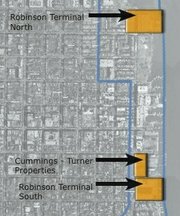City officials say the Cummings Turning property would probably be the first development on the waterfront, but until council members approve increased density the developer would be limited to the previous zoning.
Think the waterfront plan passed? Think again.
A series of challenges to the controversial small area plan have unraveled the planning document, postponing the most controversial part of the plan until a series of challenges have been resolved. At stake is the future of three sites slated for redevelopment, which would become much more valuable with the higher density council members approved in January. Despite the preliminary approval City Council members gave on Jan. 21, they were unable to pass an official ordinance formally adopting the zoning change because of pending challenges — two at the Alexandria Circuit Court and two at the Board of Zoning Appeals.
Last weekend, council members approved an amendment to the master plan but declined to take action on the zoning.
“Can you hear it? I can hear it. It’s the perfect storm,” declared former Old Town Civic Association President Townsend Van Fleet during the public hearing on the master plan amendment. “And it won’t crest here until November.”
Supporters of the plan have dismissed the challenges as last-ditch efforts to overturn the will of the City Council, which approved increased density along the waterfront in a 5-to-2 vote in January. City Attorney James Banks has described the legal challenges now pending in Circuit Court as failing to properly make a cause for action. And Planning Director Faroll Hamer has dismissed the challenges currently before the Board of Zoning Appeals as inapplicable to the course of action taken last month. Ultimately, supporters say, opponents are willing to do anything to delay the inevitable.
“It’s perpetual,” said Gina Baum, one of the founders of a pro-development group known as Waterfront for All. “Every argument I have heard against this plan is actually an argument in favor of this plan.”
THE EFFORT to move forward with the master plan amendment in the absence of a zoning change represents a change of heart at City Hall, which had once argued the two should be inseparable. In a June 13 memorandum to city council members, Hamer and Banks argued that adopting the master plan amendment and the zoning change would be “the best planning practice.” Hamer and Banks expressed concern that failing to adopt the two in tandem might lead to complications from citizens who opposed the proposed changes.
“A rezoning action includes additional potential restrictions and procedures for both the applicant and for the Planning Commission and the Council, such as a protest petition and supermajority vote requirements,” they wrote in the memorandum.
When opponents of the waterfront plan presented a protest petition in January asking for a supermajority vote, Hamer and Banks ruled that it did not apply. Because the document under consideration by the City Council was a text amendment to the zoning code rather than a map amendment to the zoning code, they said, a protest petition requiring a supermajority vote was invalid.
“If the individuals properties were coming in for rezoning, of course the protest petition would be applicable under that scenario,” said Hamer. “But we made a text amendment to the entire W-1 zone, and so the protest petition does not apply.”
HISTORICALLY, THE CITY has adopted changes to the master plan along with zoning changes, so the City Council’s decision to move forward with one in the absence of the other is out of step with the standard procedure. When the city was at an impasse on the issue earlier this year, Councilman Rob Krupicka suggested the city could move forward with one and not the other. Although Krupicka eventually voted in favor of upzoning the waterfront, he says separating the two won’t undermine the vision of the plan.
“The council could easily move forward with implementation of the master plan,” said Krupicka. “It does mean that every applicant for any land-use issue would have to come forward for a zoning amendment, but we do that with other small-area plans in the city.”
It also means, according to Hamer, that the individual applications for rezoning would be open to the protest petition process. Assuming the same property owners sign again in the future, that would mean a supermajority of six members would be required — unless the challenges are dismissed and council takes the action it intended to take in January.

